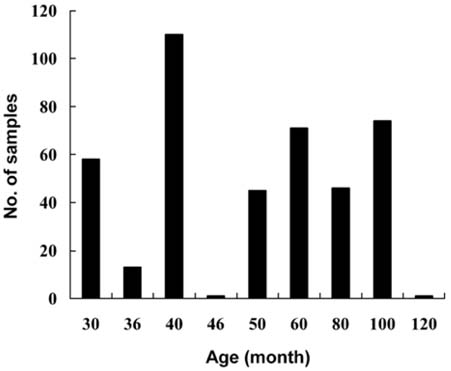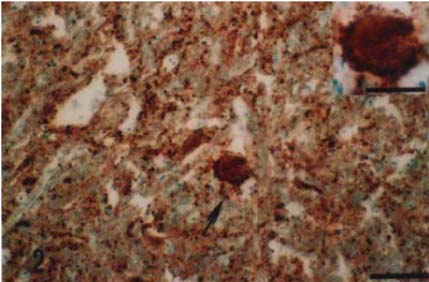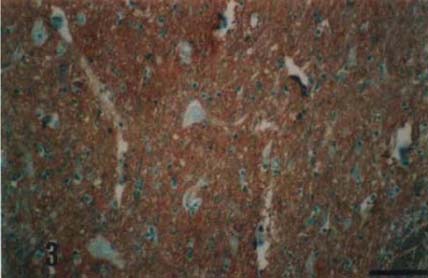J Vet Sci.
2007 Jun;8(2):193-195. 10.4142/jvs.2007.8.2.193.
Targeted surveillance to assess the presence of BSE in the age risk population of cattle slaughtered in Bursa, Turkey: preliminary results of an immunohistochemical detection study for the 2004-2005 period
- Affiliations
-
- 1Pathology Department, Faculty of Veterinary Medicine, Uludag University, Gorukle Campus, 16059 Gorukle/ Bursa, Turkey. mufitk@uludag.edu.tr
- 2Biostatistics Department, Faculty of Medicine, Uludag University, Gorukle Campus, 16059 Gorukle/ Bursa, Turkey.
- KMID: 1089673
- DOI: http://doi.org/10.4142/jvs.2007.8.2.193
Abstract
- Bovine spongiform encephalopathy (BSE), a member of the transmissible spongiform encepahlopathies, has been a notifiable disease in Turkey since 1997. In 2002, the BSE status of Turkey was assessed by the EU Scientific Steering Committee as "it is likely but not confirmed".This study presents the results of a targeted surveillance study to assess the presence of BSE in the age risk population of Bursa, Turkey. In the assessment procedure, the immunohistochemical detection of protease-resistant prion protein (PrP-Sc) was aimed at and applied to 420 brain tissues of cattle slaughtered in Bursa at an age of 30-months and older. None of the samples were positive for BSE.
Keyword
MeSH Terms
Figure
Reference
-
1. Bird SM. European Union's rapid TSE testing in adult cattle and sheep: implementation and results in 2001 and 2002. Stat Methods Med Res. 2003. 12:261–278.
Article2. Koo HC, Park YH, Lee BC, Chae C, O'Rourke KI, Baszler TV. Immunohistochemical detection of prion protein (PrP-Sc) and epidemiological study of BSE in Korea. J Vet Sci. 2001. 2:25–31.
Article3. O'Brien M. Have lessons been learned from the UK bovine spongiform encephalopathy (BSE) epidemic? Int J Epidemiol. 2000. 29:730–733.4. Office International des Epizooties (OIE). Bovine spongiform encephalopathy. Manual of Diagnostic Tests and Vaccines for Terrestrial Animals. 2004. 5th. ed. Paris: OIE;Chapter 2.3.13.5. O'Rourke KI, Baszler TV, Besser TE, Miller JM, Cutlip RC, Wells GAH, Ryder SJ, Parish SM, Hamir AN, Cockett NE, Jenny A, Knowles DP. Preclinical diagnosis of scrapie by immunohistochemistry of third eyelid lymphoid tissue. J Clin Microbiol. 2000. 38:3254–3259.6. Prusiner SB. Prions. Proc Natl Acad Sci USA. 1998. 95:13363–13383.
Article7. Scientific Steering Committee (SSC). Final Report on the Assessment of the Geographical BSE-Risk (GBR) of Turkey. 2002. EU: SSC;1–16.8. Weissmann C. Molecular genetics of transmissible spongiform encephalopathies. J Biol Chem. 1999. 274:3–6.
Article9. Wells GAH. Pathogenesis of BSE. Vet Res Commun. 2003. 27:Suppl 1. 25–28.
Article10. Wells GAH, Scott AC, Johnson CT, Gunning RF, Hancock RD, Jeffrey M, Dawson M, Bradley R. A novel progressive spongiform encephalopathy in cattle. Vet Rec. 1987. 121:419–420.
Article
- Full Text Links
- Actions
-
Cited
- CITED
-
- Close
- Share
- Similar articles
-
- Detection of Escherichia coli O157 and Escherichia coli O157:H7 by the immunomagnetic separation technique and stx1 and stx2 genes by multiplex PCR in slaughtered cattle in Samsun Province, Turkey
- Prion Diseases as Transmissible Zoonotic Diseases
- Letter to the Editor: Folliculitis Associated with Intermittant Pneumatic Compression
- Immunohistochemical detection of Prion protein (PrP-Sc) and epidemiological study of BSE in Korea
- Prevalence of ixodid ticks on cattle in Mazandaran province, Iran




